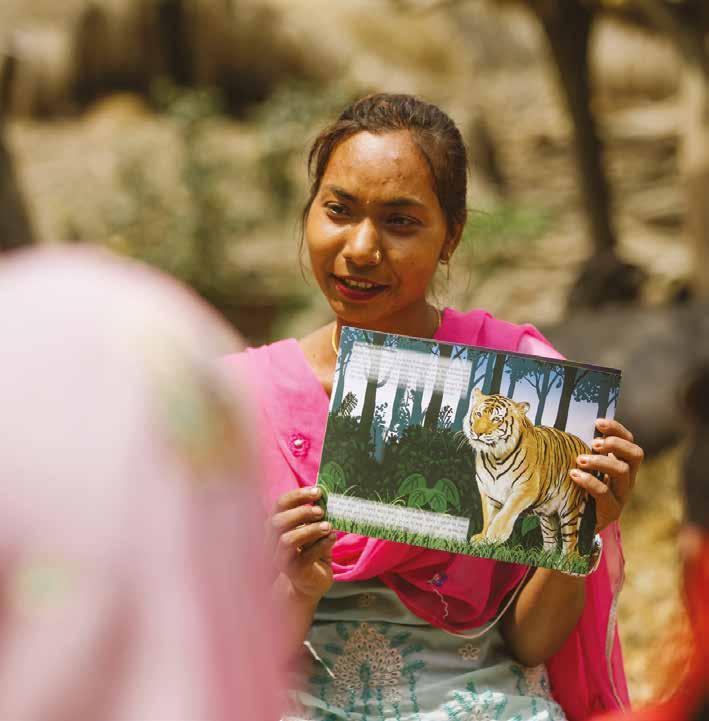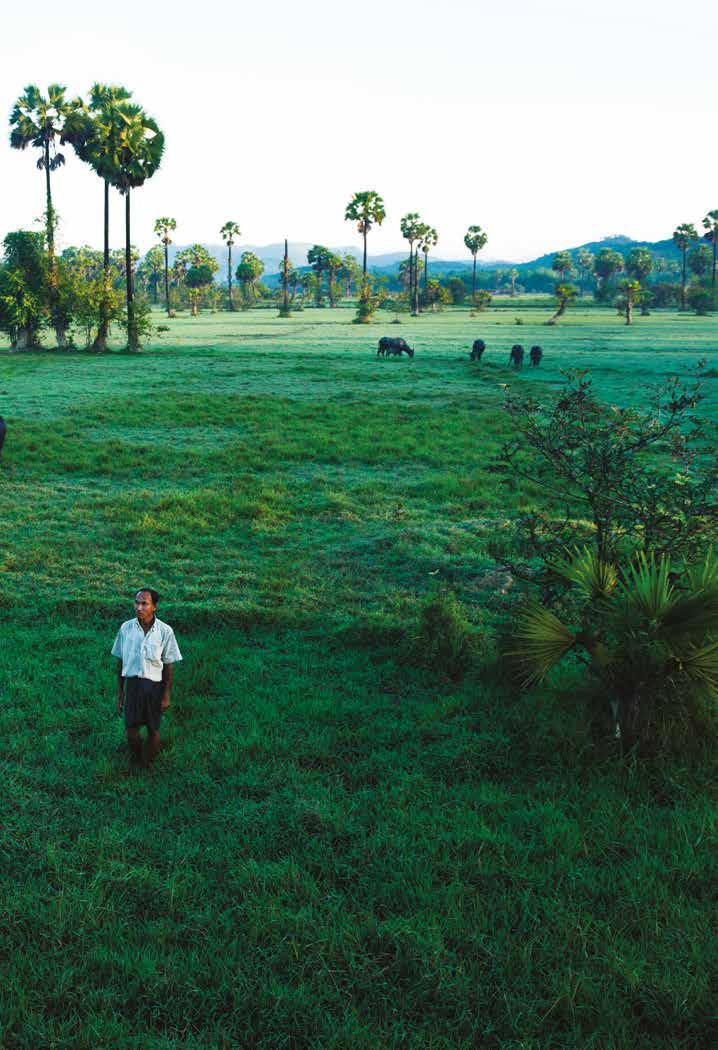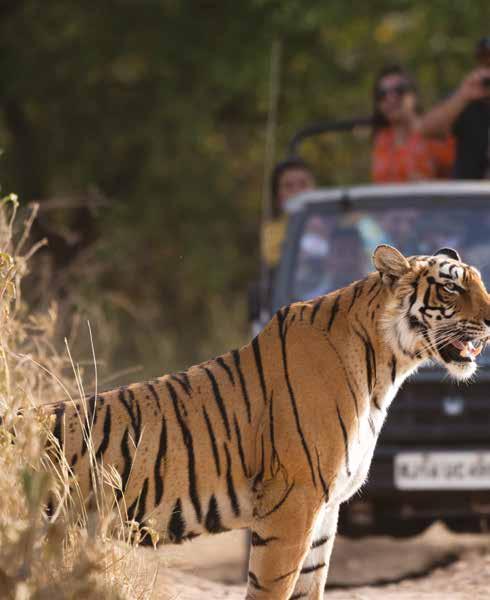
8 minute read
LIVING WITH TIGERS
©Edward Parker / WWF Confiscated animal skins

Advertisement
EU’S ROLE IN THE GLOBAL TIGER TRADE
A joint report from WWF and TRAFFIC ‘Falling Through the System: The role of the European Union captive tiger population in the trade in tigers’ in September 2020 highlighted that weak legislation and limited checks on private captive tiger facilities across the EU and the UK provide significant opportunity for tiger parts, such as skins and bones, to enter illegal trade. The report recommends immediate action to improve government oversight of the management of captive tigers, collecting DNA samples and stripe pattern photos, and to ban the commercial trade of captive tigers and their parts within and outside of the EU and UK.
The matter was raised, quoting the report, at the December CITES EU Expert Group meeting, and Member States were invited to volunteer to draft a guidance document on further controls for tiger trade, which was a recommendation from the report.
ANALYSING WILDLIFE TRADE IN RUSSIA
In recent years Russia has undertaken steps to counter the illegal wildlife trade. However according to WWF’s report ‘Wildlife Trade in the Russian Federation’, released in 2020, Russia remains an active player in the global wildlife market. Illegal trade in different Amur tiger parts and derivatives is fuelled by the demand for traditional Asian medicines, decorative items and luxury products. As Russia doesn’t have a system for monitoring and enforcing wildlife trade on the internet the report recommended there is an urgent need to develop a set of measures towards raising public awareness of restrictions in wildlife trade.
TRAFFIC LAUNCHES CAMPAIGN IN VIET NAM
Despite a global ban on trade in tigers, demand for tiger products in Viet Nam is strong and the country remains one of the main destination markets for illegal tiger trade. TRAFFIC launched a three year social marketing programme aimed at reducing the medicinal use of tiger products in Viet
©Keith Arnold / WWF-US Tiger bone wine from the Illegal Wildlife Trade
Nam. Tiger bone glue was revealed to be the most popular tiger product and will be the focus of the project. TRAFFIC will address individual demand through a multimedia behaviour change campaign, while calling on government partners, such as the National Assembly, Ministry of Health, and Central Committee of Propaganda and Education, to strengthen their policies towards wildlife protection.
CALLING FOR AN END TO TIGER 'FARMS' IN THAILAND
WWF-Thailand and World Animal Protection jointly advocated to phase out tiger ‘farms’ in Thailand, jointly submitting a petition to parliament signed by 10,000 people, asking that the Wildlife Law be amended to ban the commercial breeding of tigers in captivity. Subsequently, the CEO of WWF-Thailand presented the negative impacts that commercial breeding has on wild tiger conservation and WWF’s recommendations for phasing out tiger farms to the Minister of Natural Resources and Environment, who then prioritised the tiger farm issue in the ministry.
TIGER SEIZURE AT THAILAND ZOO
Five live tigers and a tiger head were seized from Mukda Tiger Zoo and Farm after tests showed the animals declared to be born there had no links to older tigers in the facility. The seizure refocuses the spotlight on the troubling ties between captive tigers and illegal trade involving Thailand’s zoos. Thailand’s Department of National Parks, Wildlife and Plant Conservation has said checks on tigers in these facilities would continue.
There needs to be a strong and transparent database that provides a foundation for consistent monitoring and reviewing of non-compliance. WWF-Thailand is committed to assisting Thailand's Department of National Parks, Wildlife and Plant Conservation in its ambitious goal to conduct DNA tests on the over 1500 tigers currently being held in 39 facilities across the country in the coming years and months.
LIVING WITH TIGERS.

©Emmanuel Rondeau / WWF-US
Tigers live in some of the world’s most densely populated countries. Amid increasing competition for resources, planning for tiger recovery means ensuring tigers have space to roam, breed and that their prey have the resources to flourish, in ways that benefit rather than hinder the people who share the landscapes with them.

©Emmanuel Rondeau / WWF-US

PEOPLE-CENTRED TIGER CONSERVATION
Communities must be partners in tiger conservation, rather than simply actors. That’s the fundamental shift proposed in WWF's Tigers Alive Initiative People-Centred Tiger Conservation approach.
Across the tiger’s range, people-centred approaches are already underway, from citizen science initiatives in Nepal, to partnerships with hunting estates in Russia, employment of indigenous patrol teams in Myanmar, Malaysia and Indonesia, to creation of local multi-stakeholder management bodies in Thailand, engagement with plantation managers for staff safety in Indonesia, to linking farmers in Central India with buyers of sustainably produced cotton.
What all of these approaches have in common is the greater engagement and ownership of communities in the planning, implementation and shared outcomes. This requires significantly more time and a diversity of skills to better understand the attitudes, perceptions and aspirations of communities; to be able to develop a shared vision and common ground; and, to identify and implement a range of conservation incentives that go beyond just economic benefits.
This requires a shift in the way we approach community based or inclusive conservation. In many places this is happening or ongoing and WWF's Tigers Alive Initiative aim to learn, build upon and scale up People-Centred Tiger Conservation across tiger range countries.

Birsana Yogi walking near her homestay
©WWF-Nepal

NEPAL’S PEOPLE-CENTERED APPROACH
Nepal’s Khata Corridor, a significant functional corridor, connects Nepal’s Bardia National Park to India’s Katerniaghat Wildlife Sanctuary. During the country’s last tiger survey in 2018, it was estimated that at least 34 tigers use the Khata Corridor. With increasing tiger movements, human tiger conflict in the area has also increased. In 2020, between August – September, four people were killed by a tiger around the corridor. Although these tragic incidents created terror and panic among the local government and the communities living in and around the area, there are surprisingly no records of retaliatory killings of tigers. Apart from increased tolerance, the approach with which the community took proactive steps to address the issue also exemplifies community ownership to conservation and how communities and other stakeholders in the area are embracing tiger conservation.
Hari Rani Chaudhary is a member of the community-based anti-poaching unit in Khata Corridor in Nepal’s Terai Arc Landscape
After the human tiger conflict incidence, the Khata Community Forest Coordination Committee, a community based organisation formed by WWF-Nepal two decades ago, and the Divisional Forest Office brought all the stakeholders (community representatives, forest officials, national park, district administrative authorities, local government and WWF-Nepal's Terai Arc Landscape Programme) together to address the issues and proposed immediate compensation to the families through the Community Forest Coordination Committee’s endowment fund. The community based Rapid Response Team were immediately present in the site to support concerned authorities in managing the conflict. To immediately minimise such conflicts, the Community Forest Coordination Committee in partnership with the Community based Anti-Poaching Unit, Rapid Response Team and the Bhalmansas (leaders in the indigenous Tharu communities), organised various awareness programs in and around the corridor. Khata is an example of how people-centred approaches operate in practice.
©Stephen Kelly / WWF-Myanmar

THE SAFE APPROACH
As human pressures and demands expand and wild places are transformed to feed, house, and transport people, contact with wildlife increases. And as species recovery programs succeed, there is also a likelihood that wildlife contact with people will also increase. Increasing conflict can lead to a loss of tolerance locally, and even the active removal of wildlife such as tigers.
The SAFE approach to managing human wildlife conflict gradually makes a site safer through reduction of both risk to people and their assets, as well as wildlife and their habitat. SAFE can decouple human and tiger numbers from the number of human wildlife conflict incidents.
In 2016, building upon decades of human wildlife conflict work, WWF began assessing the level of risk and safety across tiger landscapes through human wildlife conflict rapid assessment workshops. Since then assessments for sites in India, Nepal, Indonesia, Cambodia, China, and Bhutan have been completed.
The results provide valuable lessons and have shone a light on common gaps in managing human wildlife conflict. If sites are to become SAFE in the long term, it is these initial enabling features that must be put in place first. Many of the gaps identified across tiger landscapes had not been researched comprehensively, or were characterised by a lack of available substantive information. In response, WWF has instigated a series of research reports specific to these topics.
A herdsman grazes his buffalo in a field near Pyaw Daw Wa village in the Tanintharyi region, Myanmar

BUILDING KNOWLEDGE OF SAFE

WWF continues to build knowledge around the science and practice of human wildlife conflict management. New research and reports in the SAFE series continue to develop:
• Human Wildlife Conflict Index
• Economic Impact Assessment of Human Wildlife Conflict in India and Nepal
• The SAFE Rapid Assessment How to
Guide
• Human Wildlife Conflict Information
Systems
• The 6 Elements of Conflict
The proposal for a global Human Wildlife Conflict Index led by WWF's Tigers Alive Initiative was finalised in 2020 and is being put to the Convention on Biological Diversity as a potential indicator for the human wildlife conflict target.

MITIGATING HUMAN WILDLIFE CONFLICT IN NEPAL
In 2020 the first Public-Private Partnership Insurance Mechanism for Human Wildlife Conflict in Chitwan National Park was introduced. The insurance covers wildlife damage including loss of human life or injuries, damage to property, loss of livestock and crop damage.
©WWF-Malaysia
©Richard Barrett / WWF-UK Indigenous community patrol, Malaysia










